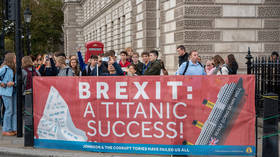Spectacular volcano eruption after 60 years of ‘silence’ captured by NASA satellite (PHOTOS)

A volcano eruption which took place on an island in the South Atlantic Ocean would have gone unnoticed if not for NASA’s satellites. The mountain erupted twice after 60 years of “silence,” releasing impressive amounts of lava.
NASA’s satellites managed to “frame” the “historic” moments which occurred on April 24 and May 1. It managed to obtain two false-colored images, which told the scientists that there had indeed been a volcanic eruption.
Many eruptions used to occur unnoticed but recent advances in satellite technology allow for the capture of striking images and the monitoring of seismic activities.

“Today, scientists can pick up signatures of events occurring far from any human observers,” NASA's Earth Observatory said in a statement.
The volcano is located on Bristol Island, which is part of the South Sandwich Islands chain. The mountain rises as far as 1,100 meters above the sea-level. Mount Sourbaya is usually toppled with ice and snow which explains why no one lives there. According to NASA, it is the least studied volcano in the world.












